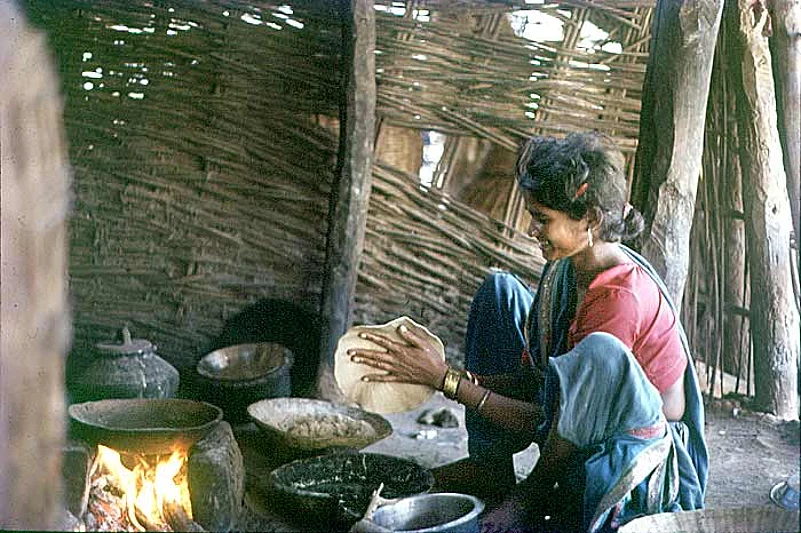When the calendar year swings between famine and feast, when short spells of plenty intersperse with long periods of paucity, people learn two lessons from an early age: how to master hunger and to exercise ingenuity in the search for food. The Bhilala adivasis, who live in the hills of the Narmada valley, look to the monsoons to water their crops of maize, sorghum and millets, pulses and oilseeds. But when the rains are uncertain and the soil yields little, it is the forest that sustains them. Many adivasis now migrate to Gujarat for work, but a large number stay behind and eke out a living—and a creative cuisine—from their fields, forests and river.
In Vanjaria’s house, the availability of food ebbs and flows with the seasons. The monsoons are the worst; when the children die, when the grain stock from the previous year runs out, when prices rise and the money earned from migrant work in the summer no longer suffices. Meanwhile, there is the hard labour of ploughing, planting and weeding to do, far harder to accomplish on an empty stomach. Vanjaria’s wife Kandli grinds coarse a fistful of corn kernels, boils them into a soup that’s fermented overnight to make raabdi: a filling meal rather like sweet corn soup, though not as nutritious as jowar roti and dal spiked with red chillies and salt which they can eat once the new crop is in.
If it is a good harvest, Vanjaria’s family stays in the village through the year, killing the occasional chicken to provide hospitality to visiting relatives and sacrificing a goat to propitiate their gods and ancestors, or to celebrate a marriage. These occasions culminate in major feasts, where fiery goat curry is eaten with roti or jowar ghaat (sorghum meal) and washed down with liquor, home-brewed from mahua flowers collected from the forest.
Mahua provides more than a high; when stewed with tuvar dal into ghugri, the flowers taste like fat fermented raisins, spiking the lentils with their musky piquancy. Oil from mahua seeds is the poor man’s ghee; it has the consistency and nuttiness of olive oil. Poured over hot jowar ghaat, it elevates a mundane meal into food for the gods.
Women and children forage in the forest in the summer when their agricultural fields lie fallow, waiting for the monsoons. They pluck tender tamarind leaves to add to dal and juicy temru (tendu) fruit and raw mangoes to snack on. Women spend early mornings by the river filtering the water through lengths of their nine-yard sarees, catching tiny fingerlings, which they then boil in a gruel of soured flour paste to make maasan khato. The men go after bigger fish, which may be grilled on a flame before being popped into an incendiary gravy of chillies and salt.
But the dish that Bhilala adivasis are best known for is not so much a product of their immediate ecological niche as it is an outcome of oppression by caste Hindus. Non-adivasi officials posted in the area would descend on the village, demanding mahua liquor, chicken and pania bread. Vanjaria recalls how his fellow-villagers scrambled to supply food in bulk, resigned to the knowledge that no payment would be forthcoming. Since caste Hindus considered contact with adivasi hearths and cooking utensils polluting, a fire would be lit outside. Maize or sorghum flour would be kneaded into a firm dough and flattened into pania—patties placed between leaves of the palash (flame of the forest) flower. On a bed of embers, the pania would be slow-roasted to smoky crispness, away from the defiling touch of an adivasi tawa. This practice is much less common today, but the meal’s association with the memory of humiliation still lingers. Delicious though it be, it leaves a bitter aftertaste.
Both pleasure and pain flavour the food of Bhilala adivasis, as does their environment, culture and history. Despite their frugal means, these industrious people improvise and manage to introduce grace notes into daily fare, rendering their poverty palatable.
Amita Baviskar, Professor, Institute of Economic Growth















